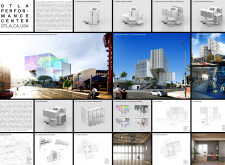5 key facts about this project
### Overview
Located at the intersection of the Little Tokyo and Arts Districts in Downtown Los Angeles, the DTLA Performance Center is designed to serve as a vibrant artistic venue that fosters community engagement and cultural expression. The center combines functional performance spaces with contemporary architectural aesthetics, carefully integrating into the urban context to encourage interaction between the building and its surroundings.
### Spatial Strategy and User Experience
The spatial organization of the Performance Center emphasizes a clear delineation between public engagement areas and dedicated performance spaces. The ground floor is designed to facilitate social interactions, while the upper levels include flexible rehearsal studios and performance venues that accommodate various artistic disciplines. This thoughtful layout encourages collaboration and creativity among users, enhancing the overall experience of visitors and performers alike.
### Materiality and Environmental Considerations
A diverse palette of materials has been employed to achieve both functional and aesthetic goals. Concrete serves as the structural backbone, delivering durability, while extensive glazing provides natural light and visual connectivity with the outdoor environment. The integration of steel within the façade adds structural strength and modern elegance. Furthermore, the design harnesses environmental efficiency through operable windows for natural ventilation and the use of thermal mass, contributing to reduced energy consumption and increased occupant comfort. LED panels further enhance the center's visual identity, allowing for dynamic artistic displays on the façade.



















































